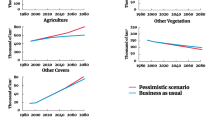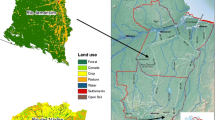Abstract
Land change science has emerged as a fundamental component of global environmental change and sustainability research. Still, much remains to be learned before scientists can fully assess future roles of land-use/cover changes (LUCC) in the functioning of the Earth system and identifying conditions for sustainable land use. The objective of this paper is to gain a better understanding of the complex interactions of human and natural drivers underlying LUCC. We do so by developing and estimating a novel structural model of land use and using spatially explicit longitudinal observations from the Upper Yangtze basin of China. Our analysis focuses on the multiple dimensions of agriculture—not only cropland use itself, but also grain production, soil erosion, and related technical change—and our data cover 31 counties over four time periods from 1975 to 2000. Our results show that technical change plays an important role in supplying food on a limited cropland; limiting cropland expansion in turn reduces soil erosion, which then benefits grain production in the longer term. It is also found that policies and institutions have significant impacts on land use and the status of soil erosion. Together, these results carry some great implications to sustainable land use and ecosystem management.


Similar content being viewed by others
Notes
To be sure, intensive farming has its own environmental problems as well, such as soil salinity and toxicity due to improper chemical applications (Ruttan 2001).
Note that the cropland area at each time point, instead of cropland change between two points, is used to ensure that the data series are consistent for each equation.
Technical change and technical adoption are conceptually different, but they are used interchangeably in this paper.
Our prior knowledge of the study site indicated that elevation, ranging from 295 to 6,109 m for the study region with a mean of 3,070 m, is a more meaningful variable, compared to, for instance, slope or range. Because elevation does not change over time, though, it will not be listed in the table of summary statistics of variables below.
According to the government statistics, included in agriculture production value are the values of animal husbandry and forestry, as well as that of farming.
To make the land use data (in pixels) compatible with the socioeconomic and other data, the former need to be aggregated to the county level based on the administrative boundary maps.
Multiple cropping refers to the situation where the cultivated land is used more than once a year. It is, thus, measured with the ratio of the total sown area divided by the total cultivated area. As such, it enhances the land-use intensity.
Field visits indicate that plastic sheeting in high elevations can effectively raise soil temperature and maintain moisture, resulting in a greater probability of crop success and higher grain yield.
References
Agarwal C, Green GM, Grove JM, Evans TP, Schweik CM (2002) A review and assessment of land-use change models: dynamics of space, time, and human choice. Gen Tech Rep NE-297. Northeastern Research Station, USDA Forest Service, Newton Square
Agricultural and Rural Development Taskforce (2004) China’s agricultural and rural development in the new era: challenges, opportunities and policy options. China Council for International Cooperation on Environment and Development (CCICED), Beijing
Chomitz KM, Gray DA (1996) Roads, land use, and deforestation: a spatial model applied to Belize. World Bank Econ Rev 10(3):487–512
Foley JA, DeFries R, Asner GP, Barford C, Bonan G, Carpenter SR, Chapin FS, Coe MT, Daily GC, Gibbs HK, Helkowski JH, Holloway T, Howard EA, Kucharik CJ, Monfreda C, Patz JA, Prentice IC, Ramankutty N, Snyder PK (2005) Global consequences of land use. Science 309:570–574
Geoghegan J, Villar SC, Klepeis P, Mendoza PM, Ogneva-Himmelberger Y, Chowdhury RR, Turner BL II, Vance C (2001) Modeling tropical deforestation in the southern Yucatán Peninsular region: comparing survey and satellite data. Agric Ecosyst Environ 85:25–46
Irwin GE, Geoghegan J (2001) Theory, data, methods: developing spatially explicit economic models of land use change. Agric Ecosyst Environ 85(1):7–23
Kaimowitz D, Angelsen A (1998) Economic models of tropical deforestation: a review. Center for International Forestry Research (CIFOR), Bogor
Lambin EF, Geist HJ, Lepers E (2003) Dynamics of land-use and land-cover change in tropical regions. Annu Rev Environ Resour 28:205–241
Lambin EF, Rounsevell MDA, Geist H (2000) Are agricultural land-use models able to predict changes in land-use intensity? Agric Ecosyst Environ 82(1–3):321–331
Lin JY (1992) Rural reforms and agricultural growth in China. Am Econ Rev 82(1):34–51
Liu JY, Liu ML, Zhuang DF, Zhang Z, Deng XZ (2003) Study on spatial pattern of land-use change in China during 1995–2000. Sci China (Ser D) 46(4):373–384
Millennium Ecosystem Assessment (2005) MA major findings. Home page at: http://www.millenniumassessment.org
Müller D, Zeller M (2002) Land use dynamics in the central highlands of Vietnam: a spatial model combining village survey data with satellite imagery interpretation. Agric Econ 27:333–354
Ruttan VW (2001) Technology, growth, and development: an induced innovation perspective. Oxford University Press, Oxford
Turner BL II, Meyer WB, Skole DL (1994) Global land-use/land-cover change: towards an integrated study. Ambio 23(1):91–95
Turner BL II, Lambin EF, Reenberg A (2007) The emergence of land change science for global environmental change and sustainability. PNAS 104(52):20666–20671
USGCRP (2004) Land use and land cover change. USGCRP program element. Available online at: http://www.usgcrp.gov/usgcrp/ProgramElements/land.htm
Veldkamp A, Fresco LO (1996) CLUE: a conceptual model to study the conversion of land use and its effects. Ecol Model 85:253–270
Verburg PH, Veldkamp WSA, Espaldon RLV, Mastura SSA (2002) Modeling the spatial dynamics of regional land use: the CLUE-S model. Environ Manage 30(3):391–405
Walker R, Moran E, Anselin L (2000) Deforestation and cattle ranching in the Brazilian Amazon: external capital and household processes. World Dev 28(4):683–699
Wang XT (2003) Building an ecological shield along the Upper Yangtze River: priorities and measures. China Agriculture Publishing House, Beijing
Wang YK, Deng YL (2007) An assessment of sediment retention capacity of ecosystem in the upper Yangtze basin (report). Institute of Mountain Hazards and Environment, Chinese Academy of Science, Chengdu
Wooldridge JM (2002) Econometric analysis of cross section and panel data. MIT Press, Cambridge
Xu JT, Yin RS, Li Z, Liu C (2006) China’s ecological rehabilitation: progress and challenges. Ecol Econ 57(4):595–607
Xiang Q, Yin RS, Xu JT, Deng XZ (2009) The driving forces of land use and land cover changes in the Upper Yangtze basin. Environ Manage. doi: 10.1007/s00267-009-9377-6
Yin RS, Hyde WF (2000) Trees as an agriculture sustaining activity: the case of northern China. Agrofor Syst 50:179–194
Yin RS, Xu JT, Li Z (2003) Building institutions for markets: experience and lessons from China’s rural forest sector. Environ Dev Sustain 5:333–351
Acknowledgments
This study was funded by the US National Science Foundation (Project 0507948). The authors are grateful for the comments and suggestions made by the reviewers and editors of this journal, as well as those by Ademola Braimoh, Jiaguo Qi, Larry Leefers, Karen Potter-Witter, and participants of the 2008 European Conference of Environmental and Resource Economics held in Gothenburg, Sweden. They also appreciate the assistance of Erin Shi and Victoria Hoelzer-Maddox.
Author information
Authors and Affiliations
Corresponding author
Additional information
Edited by Mitsuru Osaki and Ademola Braimoh, Hokkaido University, Japan.
Rights and permissions
About this article
Cite this article
Yin, R., Xiang, Q. An integrative approach to modeling land-use changes: multiple facets of agriculture in the Upper Yangtze basin. Sustain Sci 5, 9–18 (2010). https://doi.org/10.1007/s11625-009-0093-1
Received:
Accepted:
Published:
Issue Date:
DOI: https://doi.org/10.1007/s11625-009-0093-1




